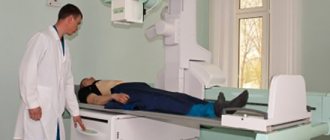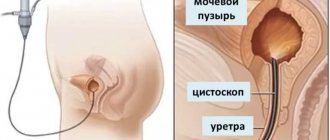Detection of urological diseases of the male genital area is rarely complete without ultrasound examination of the scrotum. In the study of pathologies in this area of the body, ultrasound has no analogues, since the organs being studied are located in hard-to-reach places. When and why a person might need an ultrasound of the scrotum, and how exactly the procedure goes, we will tell you in this article. In addition, we will consider the need to prepare for manipulation and decrypt scan data.
When is it prescribed?
Ultrasound of the scrotum is usually prescribed by a urologist, less often by a surgeon. If a doctor writes a referral to an ultrasound diagnostic room, there is a high probability that he has suspicions of pathology of the genitourinary system.
Additionally, the doctor may recommend examination of adjacent vessels. For example, if there is torsion of the spermatic cord (the second name is testicular torsion), then Dopplerography is mandatory (ultrasound with Doppler, color Dopplerography - Color Dopplerography) . So, here is the basis for prescribing an ultrasound of the scrotum:
- difficulties with conception, both with an established diagnosis of infertility and with suspected infertility;
- enlargement of the testicles or scrotum;
- lack of erection and inability to achieve it;
- swelling and pain in the scrotum area;
- development of inflammation in this area or suspicion of it, including when making diagnoses such as orchitis, orchiepididymitis, epididymitis;
- an urgent indication for scanning the scrotum is its injury , bruise and hematoma formation;
- neoplasms;
- violation of the norms of puberty in adolescents;
- questionable spermogram results;
- sometimes with inflammation of the inguinal lymph nodes (this may be a symptom of certain diseases);
- varicocele, actual or suspected;
- absence of one or both testicles;
- hormonal disorders and endocrinological diseases;
- the presence of an inguinal hernia and concerns about its advancement into the scrotum;
- undergone urological surgery or during preparation for it.
Ultrasound is also recommended in the dynamics of treatment or control of chronic diseases, including those of an oncological or inflammatory nature.
What are they watching?
Scrotal scanning is the most modern, fast and accurate diagnostic method. Ultrasound of the male genital area reveals:
- any pathologies, including those in the formative stage;
- scrotal injuries;
- causes of discomfort and pain in this area;
- causes of potency problems.
The procedure provides a valuable opportunity to find out and show the condition of organs (testicles; sometimes they may prescribe additional examination of nearby organs - for example, the prostate gland, penis), assess their parameters (maturity, potential and size), as well as non-compliance with accepted standards (anomalies, tumors , swelling, etc.).
Reference! The additional use of Doppler ultrasound allows for a detailed examination of the characteristics of the vessels and assessment of blood flow parameters.
Ultrasound of the scrotum is part of a set of mandatory examinations for men who have difficulty conceiving.
Video
This video talks about what an ultrasound of the scrotum helps to identify.
Scan Modes
There are several image imaging methods that an ultrasound machine can work with. They are achieved by enabling a certain mode on the sensor or combinations thereof.
A-mode
A-mode or “amplitude mode” gives the result in the form of a graph without a picture. It is used more often for ophthalmic examinations.
Negative aspects: not informative without combination with other modes.
A-mode
M mode
One-dimensional M-mode or “motion mode” is represented as a graph that displays time horizontally and vertically the movement of the tissue being studied. It is included to accurately measure the cavities of the heart chambers and cysts. It is used in combination with other techniques, most often B-mode.
M-mode
B-mode
B-mode or “brightness mode” is a common method of rendering a gray image. The scanner depicts 256 shades of gray, creating an accurate view of the internal organ.
B-mode
D-mode
The operation of this mode is based on the Doppler effect. Its essence lies in the difference in the speed of the transmitted and received sensor signal.
This method allows you to accurately determine:
- speed and direction of blood flow;
- speed of individual blood particles;
- turbulent flows;
- pathologies in the functioning of blood vessels.
Dopplerography indicators
CDK mode
Color Doppler mapping is a method of visualizing blood flow in color. The blood flow that goes in the direction from the sensor is red, and the one that returns to it is blue. Light shades indicate high blood speed, dark shades indicate low blood speed.
CDC allows you to detect:
- cholesterol deposits;
- vascular diseases of the extremities;
- deep vein thrombosis;
- stroke or heart attack;
- pathologies of the placenta and blood flow in the umbilical cord;
- disturbances in the functioning of the blood vessels of the neck and spine.
Color mapping
3D mode
3D mode is a three-dimensional picture. The study is prescribed to clarify previous ultrasound results.
Advantages of the method:
- more accurate data compared to other modes;
- the ability to evaluate in detail the structure of internal organs;
- issuance of three-dimensional photos.
3D ultrasound diagnostics has a higher radiation intensity than 2D ultrasound.
3D photo
4D mode
4D ultrasound makes it possible to record a diagnostic video. This modern method is mainly used in cardiology and to study the fetus of a pregnant woman. Therefore, at the end of such an ultrasound examination, the specialist will give the parents a video about the development of their unborn baby in the womb.
The advantage of this mode: the patient sees the organ or the conceived child as it is in real color. The result of the ultrasound is a hologram.
Obstetrician-gynecologist Irina Abramova talks about the advantages of 4D ultrasound on the channel “1st Medical Quarter CREDE Experto on Taganga”.
Preparation
If an ultrasound scan of the scrotum is prescribed, the adult patient should know that no special preparation is required. If we are talking about a child, then parents must prepare him, explaining the essence of the manipulations and justifying their necessity.
Important! Before the ultrasound, both adults and children should take a shower or bath and observe all hygiene measures.
Most children have a negative perception of examinations of intimate organs, so you should not neglect a detailed conversation on the eve of the procedure.
How do they do it?
The examination is carried out by a diagnostician using special equipment with a high-frequency sensor. The patient lies on his side or back, and the area to be examined is covered with a conductive gel, which is applied liberally to the skin.
Then the doctor moves the sensor over the skin, pressing it more tightly in the places of interest to the specialist. If all parameters fit into the normal range, then all manipulations will take no more than 15 minutes . But if the sonologist suspects pathologies or sees deviations from the norm, then the procedure may take half an hour.
It is possible to refer the patient from the ultrasound room directly to the urologist or surgeon's office for subsequent consultations. Sometimes even non-invasive and completely comfortable procedures can pose a risk to the health of the male genital area.
Operating principle
The operating principle of an ultrasound machine is the analysis of ultrasonic waves. The sensor produces ultra-high frequencies with a certain period of time; they, pushing off from the walls of the internal organs, return the signal to it.
A black and white picture appears on the computer monitor, which shows denser tissues in black, porous ones in gray. The diagnosis reflects real time, so the doctor can measure the speed of blood flow or see the movements of the baby in a pregnant woman.
The physical basis of ultrasound research is the piezoelectric effect.
Description of the operating principle of an ultrasonic device on the “ERSPlus Service Center” channel
Norms and decoding
During the procedure, the doctor can immediately report the abnormalities he finds, but only the attending doctor can answer in detail and accurately all questions related to the ultrasound results, diagnosis and subsequent treatment.
On the monitor of an ultrasound machine, a normal scrotum looks like echogenic tissue, consisting of several layers of different thickness and density. During the scan, its front and back parts are examined.
Appendix 1. Ultrasound form of the scrotum.
For the doctor, the parameters (size and shape) of the testicles, as well as the uniformity of their structure, are important. Moreover, tissue density depends on age : in children it is lower and will approach the parameters of an adult only during puberty.
The anatomy of the scrotum consists of two testicles, each of which has its own spermatic appendage, conventionally divided into a body, tail and head. A normal spermatic cord contains vessels, including lymphatic vessels, as well as the vas deferens.
Ultrasound of the scrotum: advantages of the technique
As you know, the scrotum consists of various membranes, inside which important structures are enclosed, including testicles, epididymis, spermatic cords, and vessels that provide tissues with oxygen and nutrients. In the presence of certain diseases of the reproductive system, sometimes a general examination and palpation of the scrotum is not enough - you also need to study its internal contents.
Ultrasound examination has a number of advantages. To begin with, it is worth saying that this is a completely painless and safe procedure that has practically no contraindications - patients can undergo it regardless of age (the examination is carried out even for small children).
Despite some excitement around the issue of the influence of ultrasonic waves on the functioning of human organs, to date there is no data that would confirm the presence of a negative effect.
In addition, a similar procedure can be performed in almost any clinic. Diagnostics using ultrasound is much cheaper than, for example, computed tomography and magnetic resonance imaging, and therefore more accessible.
Ultrasound examination with Doppler ultrasound sensors helps not only to examine the structure of the scrotal organs and determine their size, but also to study the nature of blood flow.
As for the shortcomings, there are practically none. Of course, during the procedure you can get a lot of useful information, but, for example, it is impossible to determine whether a lump in the testicular tissue is malignant or benign.
Pathologies
An approximate diagnosis can be made by a diagnostician during the scanning process, but the urologist must clarify it based on consultations and tests.
During the examination of the scrotum in children, the following is revealed:
- Dropsy (another name is hydrocele) of congenital or acquired form.
- Hypogonadism is a lack of gametogenesis and a decrease in androgens. The disease is typical for young children; the body of a healthy person independently produces the necessary components.
- Undescended testicle into the scrotum, which is not considered a pathology until a certain age and does not require correction. It is typical for the neonatal period and the condition normalizes with age.
- Calcifications.
- Manifestations of inflammatory processes.
- Cysts and tumors (very rare for children).
Adult patients are characterized by their own manifestations of pathologies, for example, in men, ultrasound makes it possible to identify:
- epididymitis;
- the presence of lymph, blood or water in the scrotum, which may result from inflammation or injury;
- purulent inflammation of the appendage;
- injuries, both open and closed;
- testicular cysts or tumors;
- infertility.











